Page 335 of 660
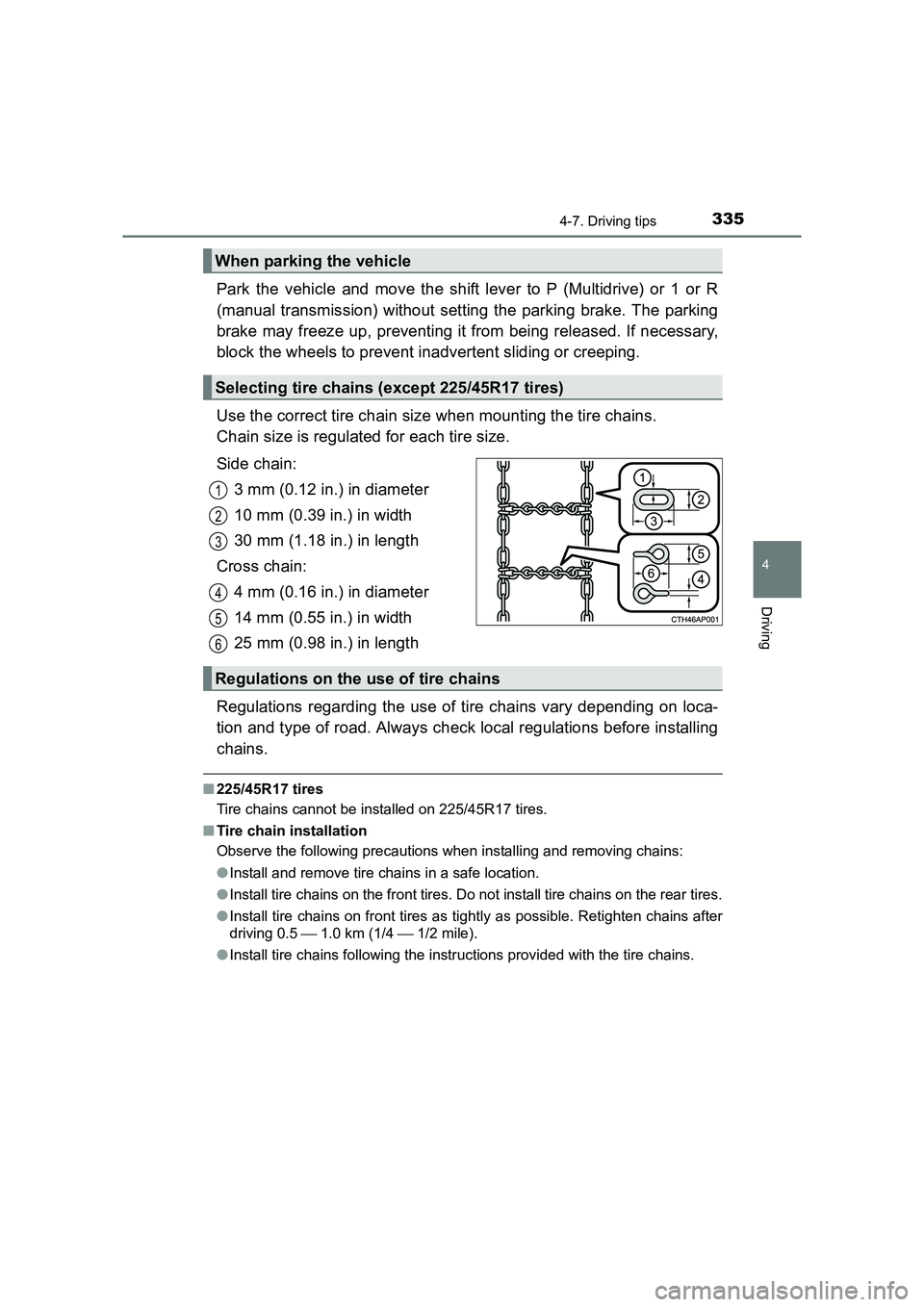
3354-7. Driving tips
AURIS Touring Sports_EE (12K53E)
4
Driving
Park the vehicle and move the shift lever to P (Multidrive) or 1 or R
(manual transmission) without setting the parking brake. The parking
brake may freeze up, preventing it from being released. If necessary,
block the wheels to prevent inadvertent sliding or creeping.
Use the correct tire chain size when mounting the tire chains.
Chain size is regulated for each tire size.
Side chain:3 mm (0.12 in.) in diameter
10 mm (0.39 in.) in width
30 mm (1.18 in.) in length
Cross chain: 4 mm (0.16 in.) in diameter
14 mm (0.55 in.) in width
25 mm (0.98 in.) in length
Regulations regarding the use of tire chains vary depending on loca-
tion and type of road. Always check local regulations before installing
chains.
■ 225/45R17 tires
Tire chains cannot be installed on 225/45R17 tires.
■ Tire chain installation
Observe the following precautions when installing and removing chains:
●Install and remove tire chains in a safe location.
● Install tire chains on the front tires. Do not install tire chains on the rear tires.
● Install tire chains on front tires as tight ly as possible. Retighten chains after
driving 0.5 1.0 km (1/4 1/2 mile).
● Install tire chains following the instru ctions provided with the tire chains.
When parking the vehicle
Selecting tire chains (except 225/45R17 tires)
1
2
3
4
5
Regulations on the use of tire chains
6
Page 534 of 660
5348-2. Steps to take in an emergency
AURIS Touring Sports_EE (12K53E)
Apply the parking brake and turn the engine switch off.
Use wheel chocks for all 4 wheels to prevent the vehicle from rolling.
Secure the vehicle by strapping
the tires to the deck of the tow
truck as shown.
Towing with a wheel-lift type truck
�XFrom the front�XFrom the rear
Release the parking brake. Use a towing dolly under the front wheels.
Using a flatbed truck
1
2
Page 536 of 660
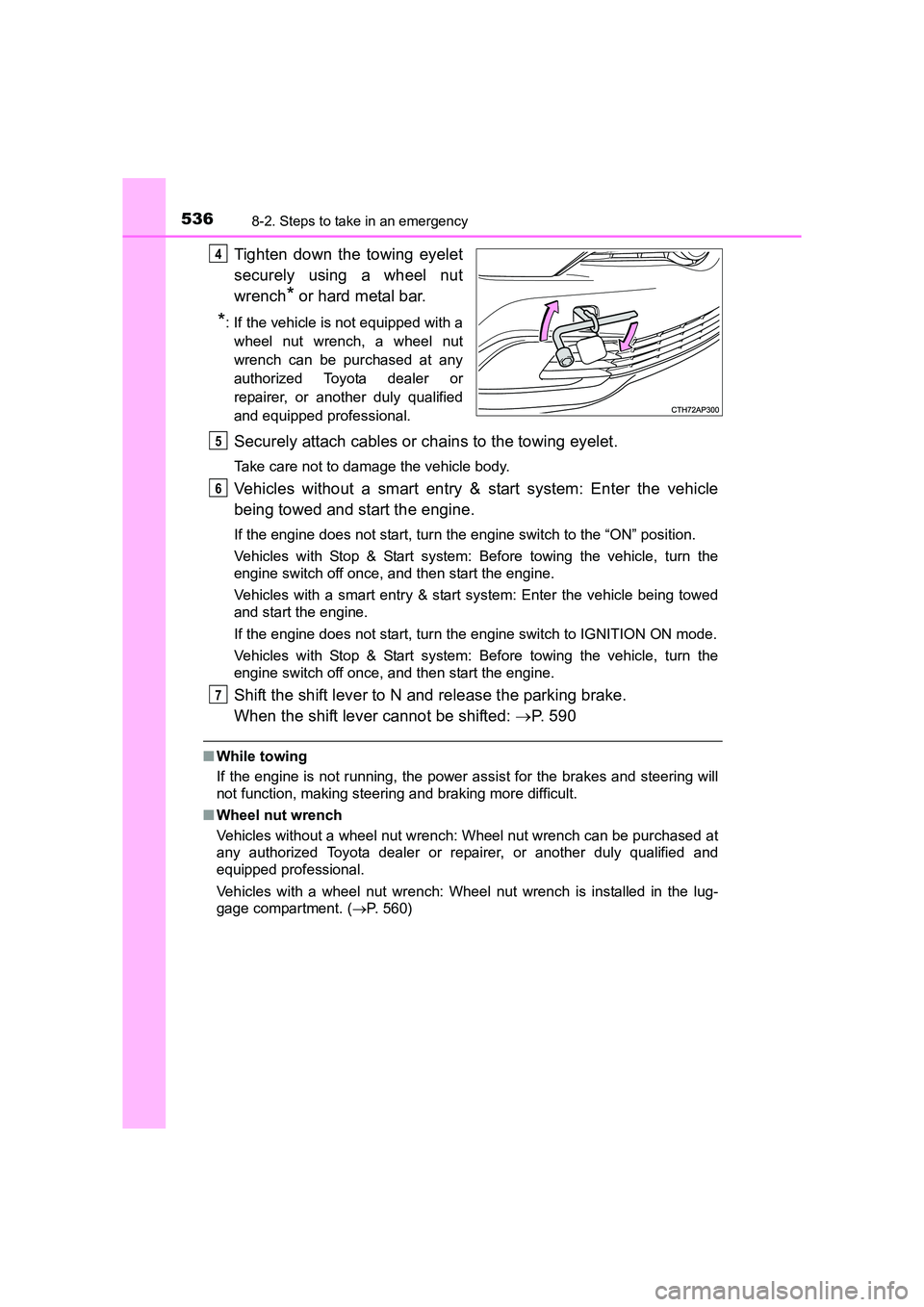
5368-2. Steps to take in an emergency
AURIS Touring Sports_EE (12K53E)
Tighten down the towing eyelet
securely using a wheel nut
wrench
* or hard metal bar.
*: If the vehicle is not equipped with awheel nut wrench, a wheel nut
wrench can be purchased at any
authorized Toyota dealer or
repairer, or another duly qualified
and equipped professional.
Securely attach cables or chains to the towing eyelet.
Take care not to damage the vehicle body.
Vehicles without a smart entry & start system: Enter the vehicle
being towed and start the engine.
If the engine does not start, turn the engine switch to the “ON” position.
Vehicles with Stop & Start system: Before towing the vehicle, turn the
engine switch off once, and then start the engine.
Vehicles with a smart entry & start system: Enter the vehicle being towed
and start the engine.
If the engine does not start, turn the engine switch to IGNITION ON mode.
Vehicles with Stop & Start system: Before towing the vehicle, turn the
engine switch off once, and then start the engine.
Shift the shift lever to N and release the parking brake.
When the shift lever cannot be shifted: →P. 590
■While towing
If the engine is not running, the power assist for the brakes and steering will
not function, making steering and braking more difficult.
■ Wheel nut wrench
Vehicles without a wheel nut wrench: Wheel nut wrench can be purchased at
any authorized Toyota dealer or re pairer, or another duly qualified and
equipped professional.
Vehicles with a wheel nut wrench: Wheel nut wrench is installed in the lug-
gage compartment. ( →P. 560)
4
5
6
7
Page 541 of 660
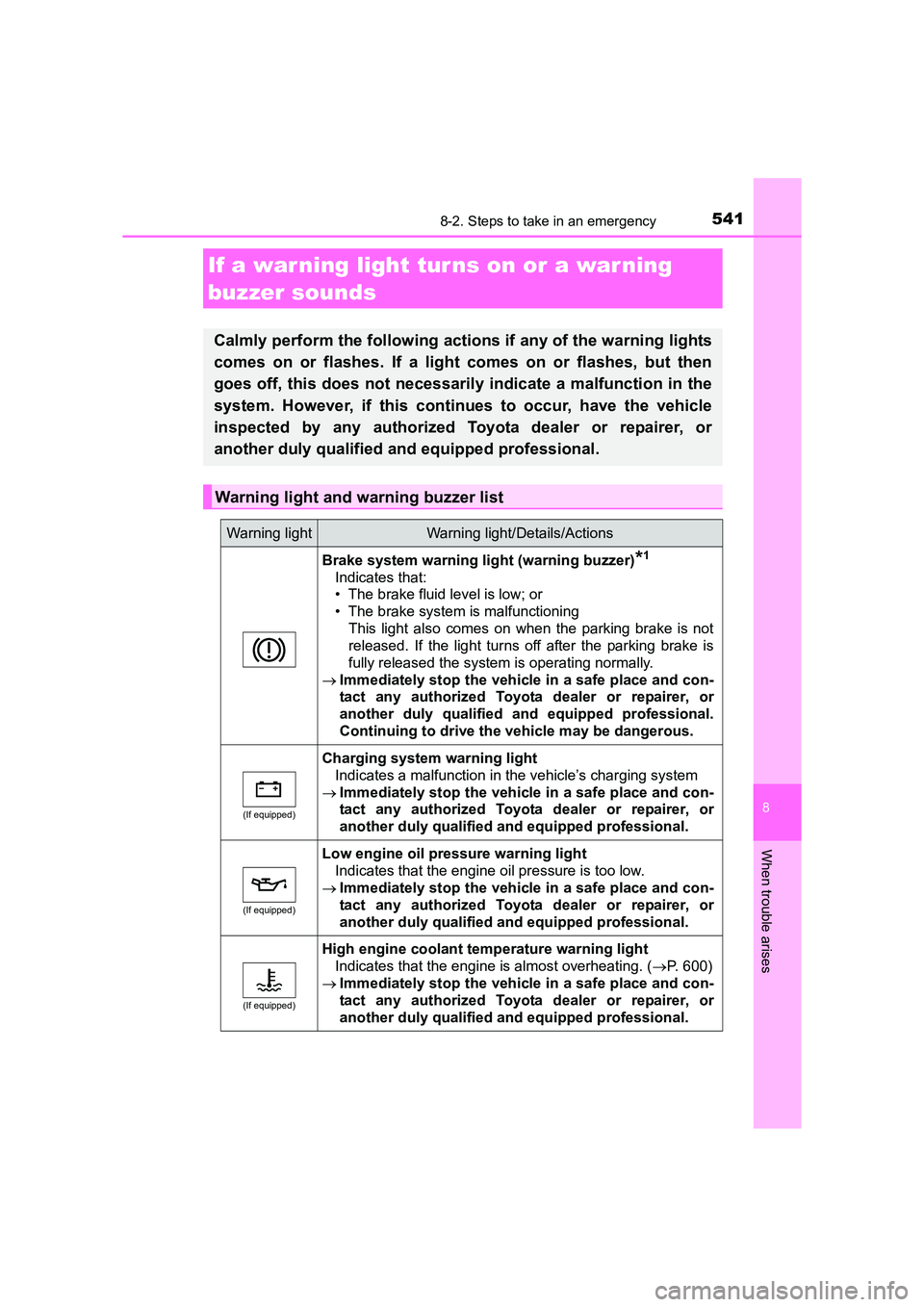
5418-2. Steps to take in an emergency
AURIS Touring Sports_EE (12K53E)
8
When trouble arises
If a war ning light tur ns on or a warning
buzzer sounds
Calmly perform the following actions if any of the warning lights
comes on or flashes. If a light comes on or flashes, but then
goes off, this does not necessarily indicate a malfunction in the
system. However, if this continues to occur, have the vehicle
inspected by any authorized Toyota dealer or repairer, or
another duly qualified and equipped professional.
Warning light and warning buzzer list
Warning lightWarning light/Details/Actions
Brake system warning light (warning buzzer)*1
Indicates that:
• The brake fluid level is low; or
• The brake system is malfunctioningThis light also comes on when the parking brake is not
released. If the light turns off after the parking brake is
fully released the system is operating normally.
→ Immediately stop the vehicle in a safe place and con-
tact any authorized Toyota dealer or repairer, or
another duly qualified and equipped professional.
Continuing to drive the vehicle may be dangerous.
(If equipped)
Charging system warning light
Indicates a malfunction in the vehicle’s charging system
→ Immediately stop the vehicle in a safe place and con-
tact any authorized Toyota dealer or repairer, or
another duly qualified and equipped professional.
(If equipped)
Low engine oil pressure warning light
Indicates that the engine oil pressure is too low.
→ Immediately stop the vehicle in a safe place and con-
tact any authorized Toyota dealer or repairer, or
another duly qualified and equipped professional.
(If equipped)
High engine coolant temperature warning light
Indicates that the engine is almost overheating. ( →P. 600)
→ Immediately stop the vehicle in a safe place and con-
tact any authorized Toyota dealer or repairer, or
another duly qualified and equipped professional.
Page 546 of 660

5468-2. Steps to take in an emergency
AURIS Touring Sports_EE (12K53E)
*1: Parking brake engaged warning buzzer: The buzzer sounds to indicate that the parking brake is still engaged (with
the vehicle having reached a speed of 5 km/h [3 mph]).
*2: The DPF system warning light may not turn off when the engine oil changereminder light is on. In this event, have the vehicle inspected by any autho-
rized Toyota dealer or repairer, or another duly qualified and equipped pro-
fessional.
*3: Open door warning buzzer: A buzzer will sound if the vehicle reaches a speed of 5 km/h (3 mph) or
more with any door open.
*4: Driver’s and passengers’ seat belt buzzer:
The driver’s and passengers’ seat belt buzzer sounds to alert the driver and
passengers that his or her seat belt is not fastened. The buzzer sounds for
30 seconds after the vehicle reaches a speed of at least 20 km/h (12 mph).
Then, if the seat belt is still unfastened, the buzzer will sound in a different
tone for 90 more seconds.
(If equipped)
Tire pressure warning light When the light comes on:
Low tire inflation pressure such as
• Natural causes ( →P. 549)
• Flat tire ( →P. 559, 572)
→ Adjust the tire inflation pressure to the specified
level.
The light will turn off after a few minutes. In case the
light does not turn off even if the tire inflation pres-
sure is adjusted, have the system checked by any
authorized Toyota dealer or repairer, or another duly
qualified and equipped professional.
When the light comes on after blinking for 1 minute:
Malfunction in the tire pressure warning system ( →P. 550)
→ Have the system checked by any authorized Toyota
dealer or repairer, or another duly qualified and
equipped professional.
(If equipped)
Master warning light A buzzer sounds and the warning light comes on and
flashes to indicate that the master warning system has
detected a malfunction.
→ P. 553
Warning lightWarning light/Details/Actions
Page 559 of 660
5598-2. Steps to take in an emergency
AURIS Touring Sports_EE (12K53E)
8
When trouble arises
●Stop the vehicle on a hard, flat surface.
● Set the parking brake.
● Shift the shift lever to P (Multidrive) or R (manual transmission).
● Stop the engine.
● Turn on the emergency flashers. ( →P. 530)
If you have a flat tire (vehicles with a spare
tire)
Your vehicle is equipped with a spare tire. The flat tire can be
replaced with the spare tire.
For details about tires: →P. 4 8 6
WARNING
■ If you have a flat tire
Do not continue driving with a flat tire.
Driving even a short distance with a flat tire can damage the tire and the
wheel beyond repair, which could result in an accident.
Before jacking up the vehicle
Page 572 of 660
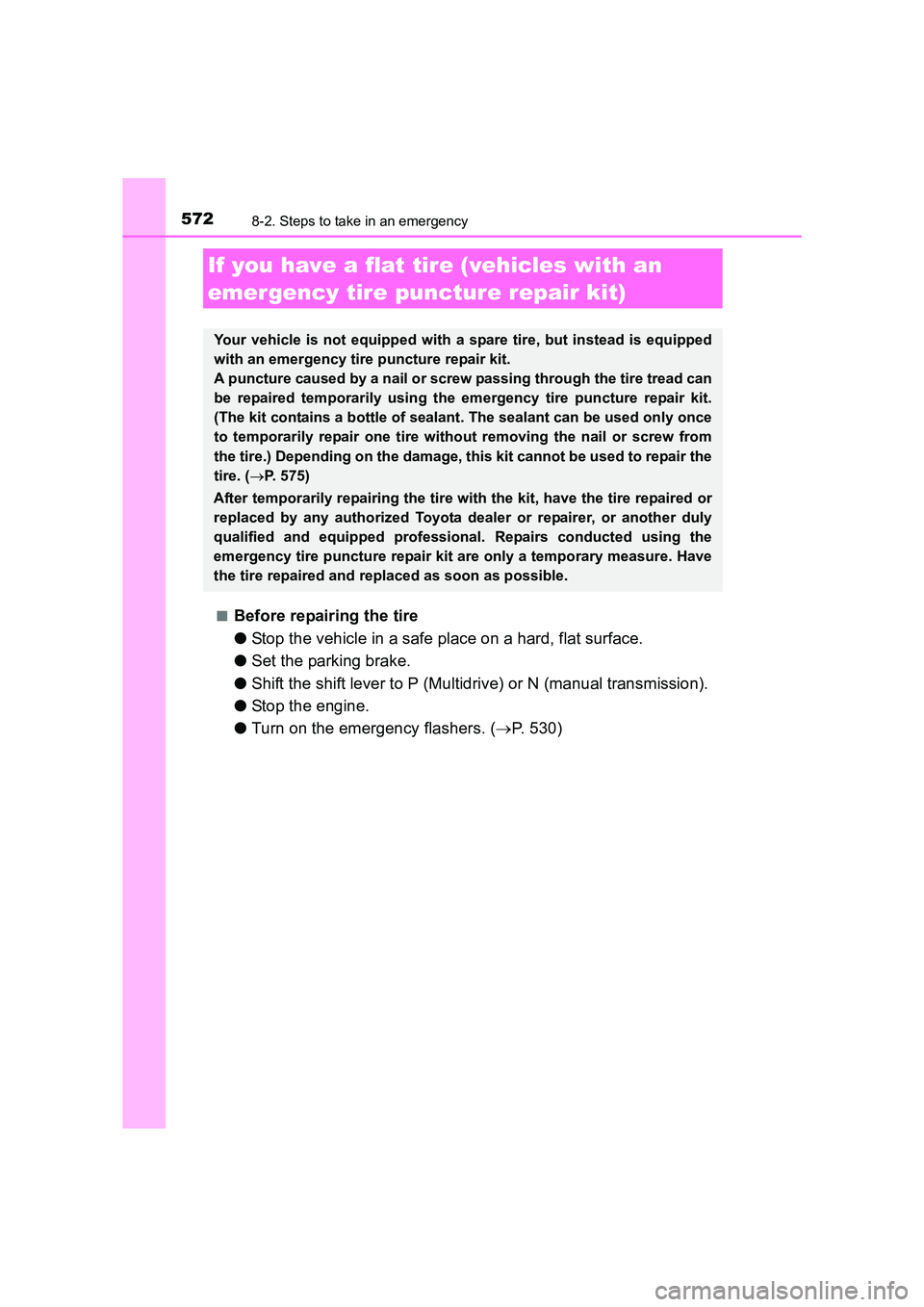
5728-2. Steps to take in an emergency
AURIS Touring Sports_EE (12K53E)■
Before repairing the tire
●
Stop the vehicle in a safe place on a hard, flat surface.
● Set the parking brake.
● Shift the shift lever to P (Multidrive) or N (manual transmission).
● Stop the engine.
● Turn on the emergency flashers. ( →P. 530)
If you have a flat tire (vehicles with an
emergency tire puncture repair kit)
Your vehicle is not equipped with a spare tire, but instead is equipped
with an emergency tire puncture repair kit.
A puncture caused by a nail or screw passing through the tire tread can
be repaired temporarily using the emergency tire puncture repair kit.
(The kit contains a bottle of sealant. The sealant can be used only once
to temporarily repair one tire without removing the nail or screw from
the tire.) Depending on the damage, this kit cannot be used to repair the
tire. ( →P. 575)
After temporarily repairing the tire with the kit, have the tire repaired or
replaced by any authorized Toyota dealer or repairer, or another duly
qualified and equipped professional. Repairs conducted using the
emergency tire puncture repair kit are only a temporary measure. Have
the tire repaired and replaced as soon as possible.
Page 589 of 660
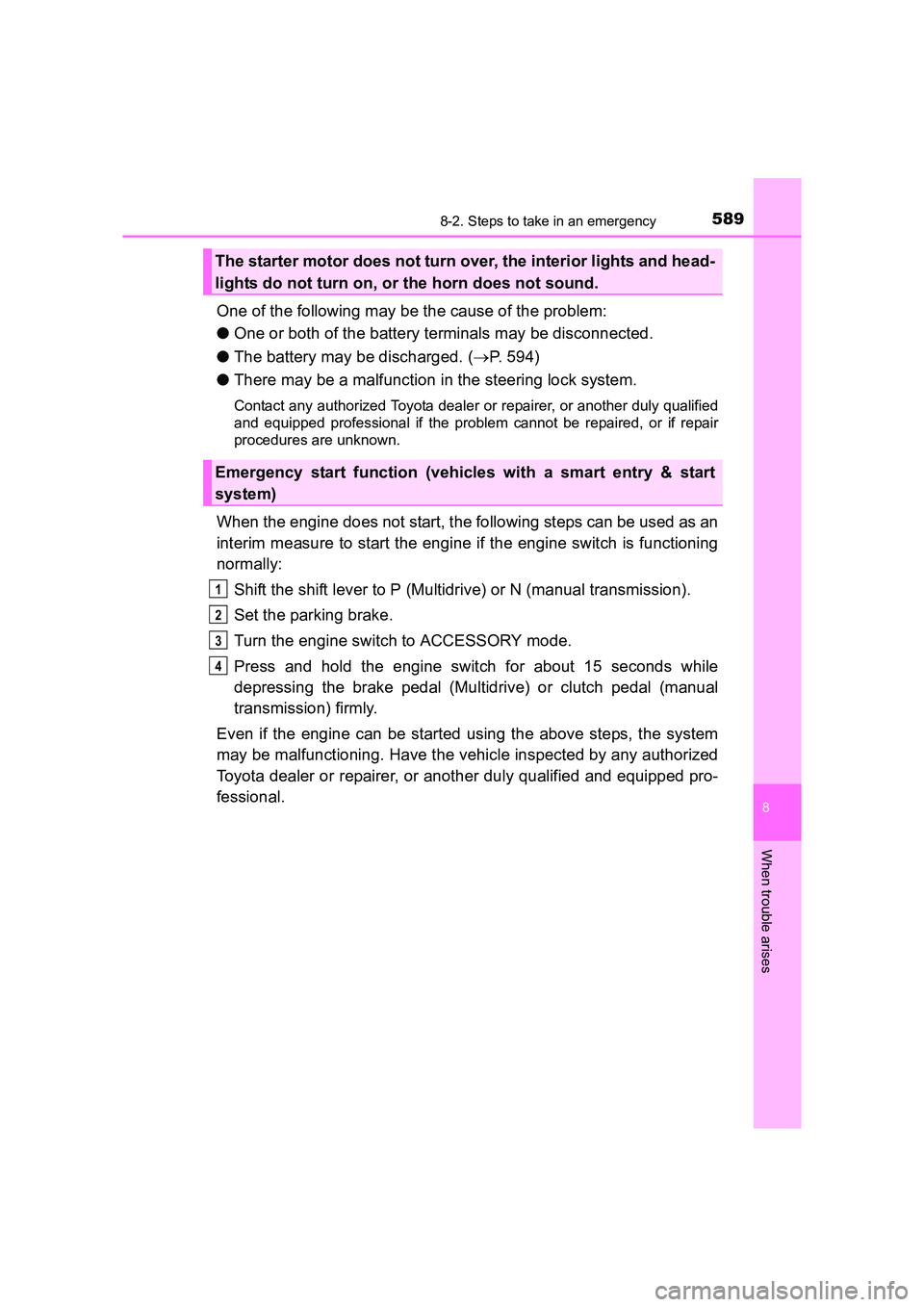
5898-2. Steps to take in an emergency
AURIS Touring Sports_EE (12K53E)
8
When trouble arises
One of the following may be the cause of the problem:
●One or both of the battery terminals may be disconnected.
● The battery may be discharged. ( →P. 594)
● There may be a malfunction in the steering lock system.
Contact any authorized Toyota dealer or repairer, or another duly qualified
and equipped professional if the problem cannot be repaired, or if repair
procedures are unknown.
When the engine does not start, the following steps can be used as an
interim measure to start the engine if the engine switch is functioning
normally:
Shift the shift lever to P (Multidrive) or N (manual transmission).
Set the parking brake.
Turn the engine switch to ACCESSORY mode.
Press and hold the engine switch for about 15 seconds while
depressing the brake pedal (Multidrive) or clutch pedal (manual
transmission) firmly.
Even if the engine can be started using the above steps, the system
may be malfunctioning. Have the vehicle inspected by any authorized
Toyota dealer or repairer, or another duly qualified and equipped pro-
fessional.
The starter motor does not turn over, the interior lights and head-
lights do not turn on, or the horn does not sound.
Emergency start function (vehicles with a smart entry & start
system)
1
2
3
4